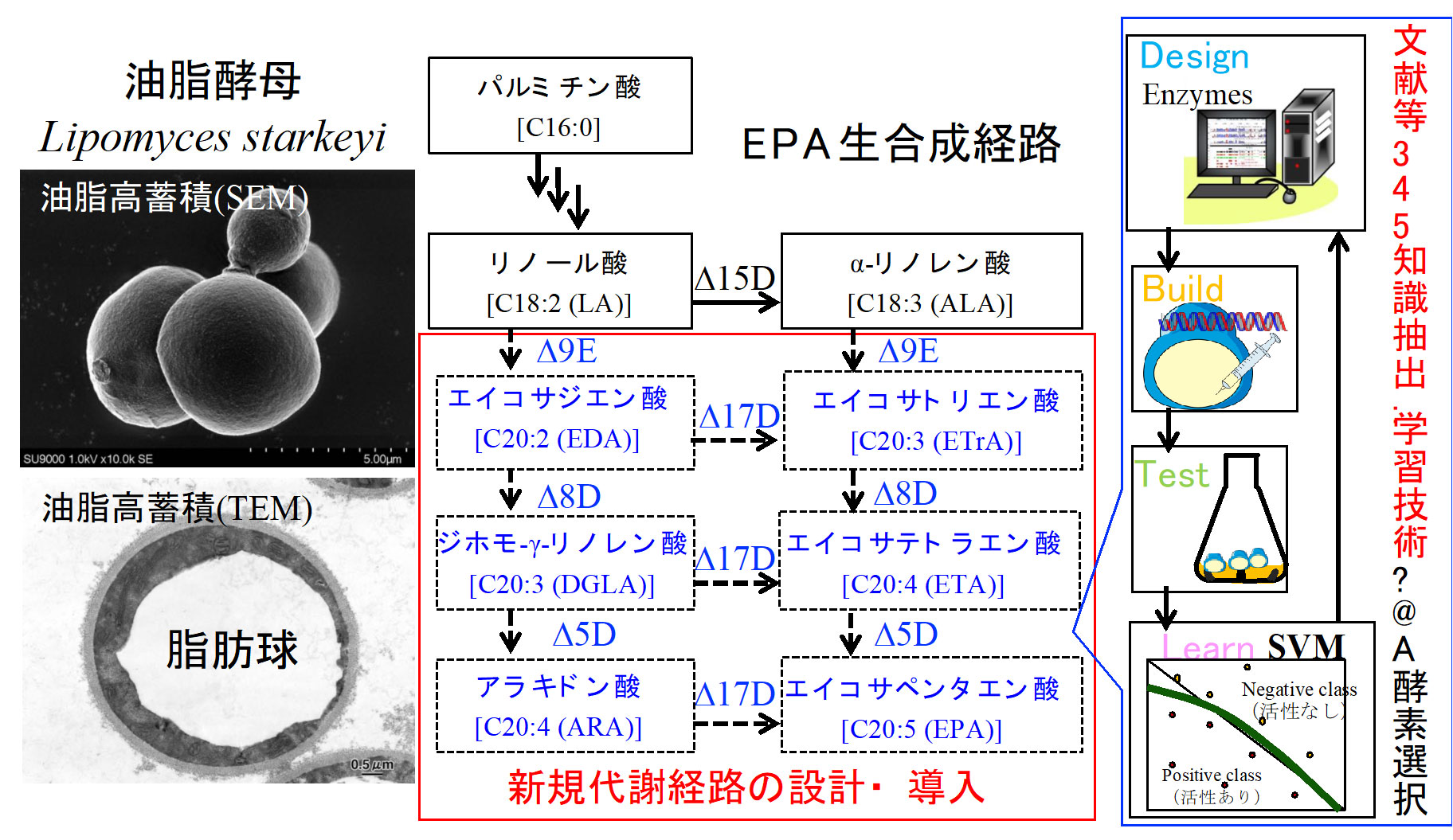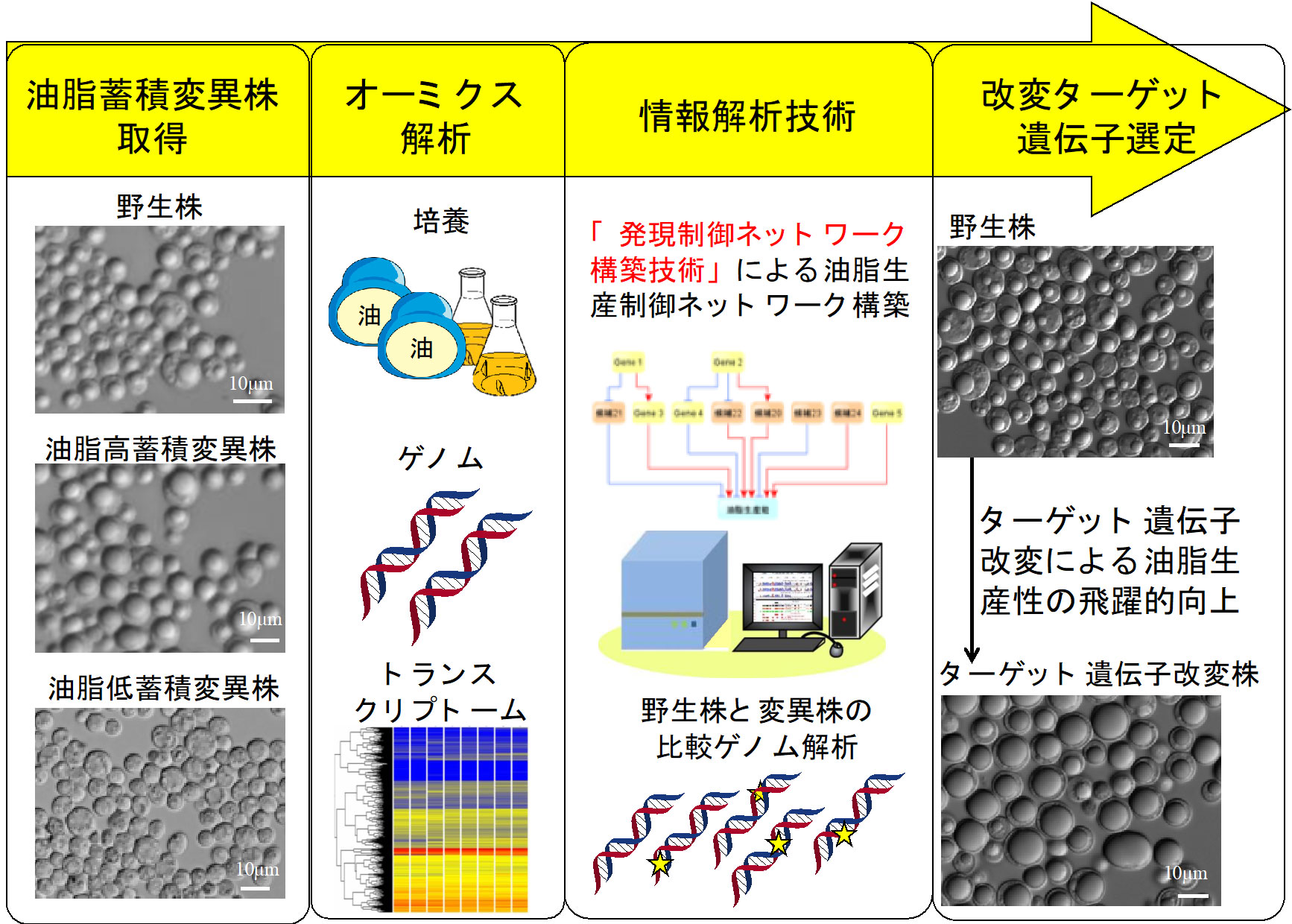Improvement in productivity to produce ω-3 polyunsaturated fatty acid-containing lipids


Expression Regulation Network Construction, Knowledge Extraction and Learning from Literature, etc.(Proposing Enzymes Utilizing Machine Learning and Knowledge Base Supporting Smart Cell Designing), Long-chain DNA Synthesis, High-accuracy Metabolomic Analysis, and Quantitative Targeted Proteomic Analysis
Niigata University of Pharmacy and Applied Life Sciences, Fuji Oil Holdings Inc., National Institute of Advanced Industrial Science and Technology (AIST), Institute of Physical and Chemical Research (RIKEN), Nagaoka University of Technology, Osaka University, Kyoto University, Kyushu University, and Kobe University
To develop a new oleaginous yeast that can synthesize ω-3 fatty acids with high efficiency, for contributing to the ω-3 fatty acid market where the supply is running short of demand due to overfishing, etc.
ω-3 fatty acids, classified as polyunsaturated fatty acids, are known as essential fatty acids, which cannot be synthesized in the human body, and are vital to maintain the function of the brain and retina. Foods rich in ω-3 fatty acids are limited to some vegetable and fish oils. Therefore, we should consciously consume such foods. In addition, since α-linolenic acid, an ω-3 fatty acid, is converted to eicosapentaenoic acid (EPA), which prevents arteriosclerosis, and also to docosahexaenoic acid (DHA), which prevents dementia, their recommended daily intake has been set in many countries in the world, to ensure their consumption. Due to the rapid increase in the demand for ω-3 fatty acids, the global market is expanding, especially in the emerging countries. However, the supply of fish oil, which is the raw material for ω-3 fatty acids, continues to decline due to overfishing, and therefore the supply meeting the demand may not be secured in future. In some overseas countries, commercial production of ω-3 fatty acids in microalgae has begun. However, the production efficiency is poor, and the price is several times higher than those derived from fish oil. Therefore, the supply from the production to the market is far from adequate. Considering these circumstances, we have focused on Lipomyces starkeyi, an oleaginous yeast, which has a high potential to store intracellular lipids in excess of 70% of its dry cell weight, and are aiming to construct a new oleaginous yeast that can produce lipids containing high amounts of ω-3 polyunsaturated fatty acids.
[1] Modification of fatty acid composition (improvement in the ω-3 fatty acid content)
By genomic analysis, etc., L. starkeyi, an oleaginous yeast, can only synthesize α-linolenic acid as an ω-3 fatty acid. In order to synthesize EPA and other ω-3 polyunsaturated fatty acids, which are more unsaturated than α-linolenic acid, in oleaginous yeasts, we first introduced the ω-3 polyunsaturated fatty acid synthetic pathway in L. starkeyi, using basic technologies for smart cells ("Technology of Knowledge Extraction and Learning from Literature, etc." and "Long-chain DNA Synthesis Technology"). Then, we selected and modified enzymes to improve the ω-3 fatty acid content. As a result, we succeeded in producing ω-3 polyunsaturated fatty acids in L. starkeyi, an oleaginous yeast, with an improved content.

[2] Improvement in lipid productivity (improvement in lipid content, and improvement in lipid yield relative to sugar)
In order to improve lipid productivity, we acquired mutant strains that accumulate large amounts of lipid,1,2 and performed omics analysis ("High-accuracy Metabolomic Analysis Technology" and "Quantitative Targeted Proteomic Analysis Technology"). Then, by a basic technology for smart cells ("Expression Regulation Network Construction Technology") in which the obtained data were utilized, we constructed a lipid production network and have found a new factor controlling the lipid production. In addition, using the factor, we succeeded in an about 2-fold increase in the lipid productivity. Moreover, by identifying causative genes through a comparative genomic analysis of wild strains and mutant strains that accumulate lipids, we found a new lipid production controlling factor different from the above one, and by utilizing the factor, we succeeded in an about 4-fold increase in the lipid productivity.

Japanese Unexamined Patent Publication No. 2019-146543
Last updated:December 25, 2023